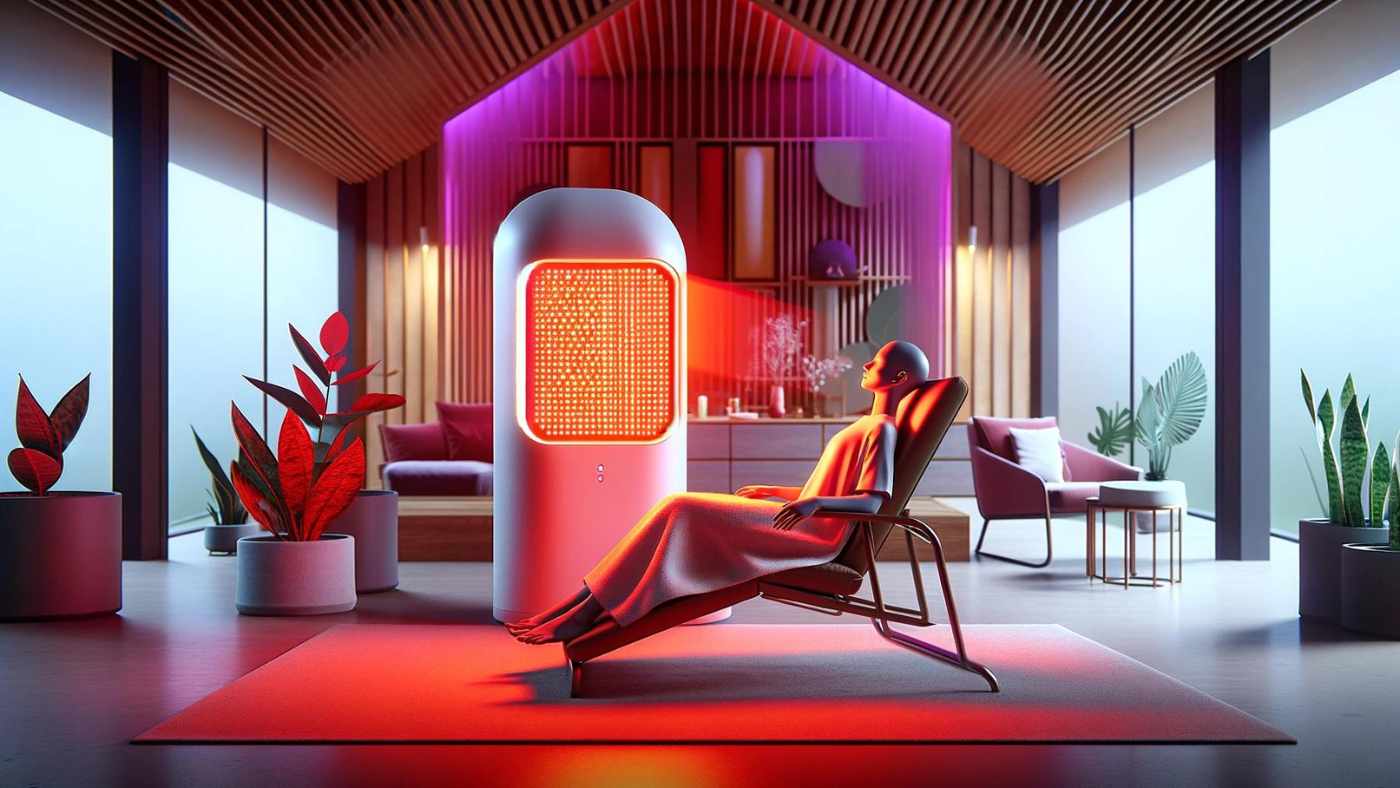Red Light Therapy for Healthy Skin (How It Works)

Are you tired of persistent skin problems? Discover the transformative power of red light therapy, a cutting-edge, non-invasive treatment revolutionizing the skincare world. This extraordinary therapy effectively addresses common issues such as acne, redness, sun damage, and unwanted hair growth.
In this blog post, we'll delve into the science behind red light therapy, revealing how it rejuvenates your skin from the inside out. We'll also highlight its incredible benefits, leaving your skin looking better and healthier.
So, why not settle in, or better yet, bask under that calming red glow as we uncover why red light therapy could be the secret weapon you've been searching for to unlock your skin's natural radiance and vitality? Get ready to say goodbye to stubborn skin issues and hello to a healthier, more confident you.
Key Takeaways- Stimulates Collagen Production: Red light therapy benefits the skin by stimulating collagen production, reducing fine lines, wrinkles, acne scars, sun damage, and improving skin complexion.
- Deep Penetration and Activation: Red light therapy penetrates deep into the skin, activating cells to generate energy and enhance blood flow and oxygenation.
- Safety and Side Effects: This innovative treatment is generally safe, but mild side effects such as redness or irritation may occur, so following treatment guidelines carefully is essential.
How Does Red Light Therapy Benefit Skin?
Stimulates Collagen Production
One of the most significant benefits of red light therapy for your skin is its ability to stimulate collagen production. Collagen, a naturally occurring protein in our bodies, provides structure, strength, and elasticity to our skin.
Red light therapy uses specific wavelengths of light to penetrate deep into the layers of your skin, activating cells called fibroblasts, which are essential for producing new collagen fibers. Studies have shown increased collagen and elastin levels in subjects who underwent red light therapy sessions for 12 weeks.
Reduces Wrinkles, Acne Scars & Sun Damage
Red light therapy combats acne scars and reduces wrinkles and sun damage by stimulating collagen production and supporting the regeneration of damaged skin tissue.
Consistent treatment sessions following proper guidelines for treatment area and time exposure to LED light therapy or Low-Level Laser Therapy (LPLT) significantly improve skin texture and tone (1) within a few weeks.
Improves Skin Complexion
Imagine having a radiant, even-toned complexion that turns heads and boosts your confidence. Red light therapy promotes cellular health and addresses common skin concerns like uneven pigmentation and dullness.
Controlled trials have shown significantly improved skin complexion (2) and reduced roughness in treated subjects.

How Does Red Light Therapy Work on the Skin?
Red light therapy penetrates deep into the skin, activating cells to produce energy and increasing blood flow and oxygenation.
Penetrates Deep into Your Skin
Target hard-to-reach areas of your skin with the deep penetration of red light therapy, surpassing the limitations of topical treatments.
This treatment stimulates cellular energy production and increases blood flow, producing better tissue oxygenation.
Activates Cells to Produce Energy
Red light therapy works by activating cells in the skin to produce more energy, which enhances cell functions such as repairing and boosting new cell growth.
This process, known as photobiomodulation, involves stimulating mitochondria, which generate cellular energy.
Increased ATP (adenosine triphosphate) production (3) from stimulated mitochondria can enhance cellular, muscle, and overall health.
Increases Blood Flow & Oxygenation
Red light therapy boosts blood flow and oxygenation in the skin (4). By improving blood flow and increasing oxygen delivery to the skin's surface, RLT helps reduce inflammation, promote healing, and revitalize overall.
This increased blood flow delivers vital nutrients to the skin cells, promoting healthy cell growth for a rejuvenated appearance.

Side Effects & Safety of Red Light Therapy for Skin
Red light therapy is generally safe, but mild side effects such as redness or irritation may occur. Wearing appropriate eye protection and following a proper skincare regimen is essential.
Generally Safe
Red light therapy is a non-invasive treatment that can be safely practiced at home, making it accessible to anyone looking to improve their skin's appearance or address chronic skin conditions like acne or rosacea.
However, overusing light therapy can have risks, such as premature skin aging and an increased likelihood of skin cancer later in life.
Possible Redness or Irritation
Mild side effects, such as temporary redness or irritation of the treated area, may occur due to the wavelengths of light penetrating deep into the skin, stimulating blood flow and cellular activity.
To minimize risk, consult with your dermatologist before starting any treatment regimen at home. Wear protective goggles or keep them closed during the sessions to protect your eyes.
Related Studies:
- This systematic review assesses the effectiveness of photobiomodulation therapy, including red light therapy, in reducing wrinkles, acne scars, and sun damage, concluding that it is a promising non-invasive treatment option.
- This randomized controlled trial investigates the effects of red light therapy on skin complexion and roughness, finding that it significantly improves skin complexion and reduces roughness.
- This review discusses the role of photobiomodulation, including red light therapy, in stimulating mitochondria to enhance ATP production and highlights its potential therapeutic applications.
- This systematic review examines the effects of red light therapy on blood flow and oxygenation in the skin, concluding that it significantly increases these.
Conclusion
Discover the exceptional benefits of red light therapy for improving your skin's appearance. This treatment effectively reduces fine lines, wrinkles, and acne scars and enhances complexion.
By penetrating deep into the skin and stimulating collagen production, it rejuvenates damaged tissue and improves cellular health. While there may be mild side effects like redness or irritation, it's a safe treatment with FDA-approved devices available.
Ready to transform your skin? Visit the Wild Foods Co. Red Light Therapy Shop today! Discover our range of red light therapy products designed to rejuvenate your skin and boost your overall health. Don't wait; your skin will thank you.
FAQ
What is red light therapy, and how does it rejuvenate the skin?
Red light therapy uses low-wavelength red light to stimulate collagen and elastin production, improving skin texture and reducing wrinkles for healthier, more radiant skin.
What are the benefits of red light therapy for skin health?
Red light therapy smooths skin, reduces wrinkles, treats acne scars, burns, and UV sun damage, decreases inflammation, and promotes hair growth, enhancing skin health.
Which skin conditions can red light therapy treat?
Red light therapy treats acne, eczema, psoriasis, rosacea, sun damage, age spots, and actinic keratosis, making it a versatile solution for various skin conditions.
Is red light therapy suitable for all skin types?
Generally, red light therapy is considered safe for all skin types. It's non-invasive and doesn't involve harsh chemicals or abrasive exfoliants. However, overexposure may potentially damage skin tissue, so following recommended usage guidelines is crucial. Always consult with a healthcare provider before starting new treatments.
How long does red light therapy take to work on the skin?
Improvements can be noticed after one session of red light therapy, but multiple sessions over weeks or months may be necessary for optimal results.
What are the cons or side effects of red light therapy?
Minor side effects of red light therapy may include temporary redness, itchiness, or dryness. Eye protection is necessary during treatment to prevent potential harm.
